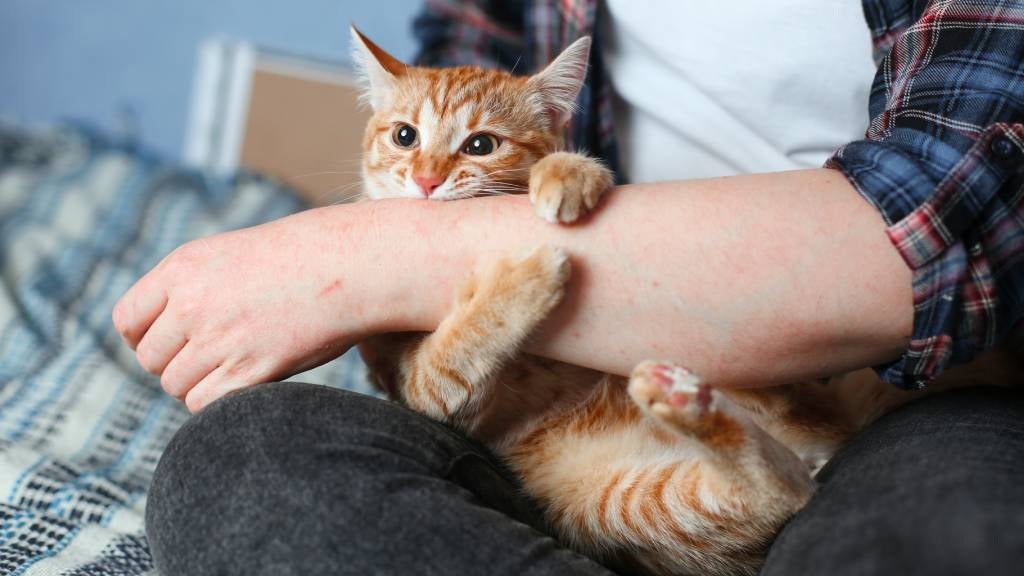Cat biting: Playful nips or cause for concern?

Ever enigmatic, cats can be difficult to understand sometimes. One moment, they are rubbing against your leg, purring, and the next minute, they are biting the hand that feeds them – literally!
Cats are playful creatures, and biting can be a standard play behaviour. They may nip or lightly bite to initiate a game or show affection. However, there are times when biting can be a sign of aggression or distress.
To help us break down the cat code, CANZ Accredited Animal Behaviour Consultant, Mat Ward (BSc MVS CCAB), offers insight from inside the feline mind so you can work out where the line lies between an innocent nip during play and something more aggressive.
What does it mean when cats bite?
"Cats are predators, so they also tend to rehearse their hunting skills by pouncing on and biting feet and other moving objects in their environment," Mat Ward tells us.
"This is normal, but to save your feet from becoming pincushions, make sure to provide regular opportunities for this behaviour," he adds.
Cats have a range of communication cues, and biting is just one of them. When cats bite, or are aggressive, it can mean different things depending on the context in which it occurs. It's important to pay attention to the body language and other signals your cat may be showing before and during the biting behaviour.
Differentiating playful biting from aggression
Mat helps us understand a cat's intentions behind biting through a traffic light system.
- Green (playful bites): Biting is a part of healthy play between a cat and a human, especially for kittens who use play to learn and develop. Playful biting is accompanied by other play body language, such as grabbing and holding with the front paws and "bunny kicks" of the back feet, Mat explains. If the game gets out of hand and the bites become painful, stop the game or redirect the behaviour to a toy instead of your body. Resist the urge to pull your hand away quickly, as this can trigger a stronger grip. Instead offer a toy to distract them while you safely remove your hand.
- Orange (warning bites): A warning bite is a cat's way of saying they've had enough. To demonstrate their warning, these kinds of bites are often paired with a swishing tail. "A common example of this is when they are stroked in ways they dislike," Mat says. "Often this is when a cat’s tummy is stroked, but sometimes a cat may switch from enjoying or tolerating handling to not wanting to be touched." Let cats choose if they want to be touched, stick to preferred areas like the head, cheeks and chin, and pay attention to their body language to spot when they might have had enough.
- Red (aggressive bites): Biting is also used in situations where a cat is experiencing stress in the form of fear, anxiety or anger. Other warning signs to look out for include growling, hissing, and flattened ears. Aggressive bites often come from a sense of being threatened and a desire for space.
Recognising normal play behaviour
As mentioned, play is a natural and essential behaviour for cats. It helps them to develop their physical abilities, practice hunting skills, and release pent-up energy.
It's also important to establish clear boundaries during playtime. If your cat starts to bite too hard or scratch too aggressively, stop the game and give them some time to calm down before resuming play. Wand toys can be useful for playing with your cat while keeping your hands out of reach.
Nips
It's important to differentiate between playful nips and aggressive bites. Playful nips are gentler and more controlled, with the cat being careful not to cause any harm. On the other hand, aggressive bites are often harder and more forceful, sometimes resulting in injury.
Swipes
Swiping allows them to practise their hunting skills and keep their reflexes sharp. When your kitty is in play mode, these swipes tend to be quick and light, often accompanied by other playful signals. Playful pawing is often gentle and controlled, whereas aggressive pawing can be more forceful and accompanied by growling or hissing.
Chases
Chasing is another vital aspect of a cat's play behaviour and is completely natural. It's not just about having fun – though that’s definitely a part of it! Chasing allows cats to tap into their predatory instincts, honing skills they’d use in the wild to track and catch prey.
What does aggressive cat biting look like?
Aggressive cat biting often looks quite different from their playful nips. When a cat bites aggressively, it can happen unexpectedly and with noticeable intensity.
You might see the cat's body language shift to something more tense – a low growl, flattened ears, and dilated pupils are tell-tale signs.
The bite itself is usually strong and meant to intimidate or defend rather than in the spirit of fun. Cats might bite aggressively due to fear, pain, or overstimulation during play. Understanding the context surrounding these bites helps address the root cause and set boundaries.
What to do if a cat bites you
Cat bites should always be taken seriously, even if they seem small. Proper care and medical attention can help prevent complications. Clean the wound thoroughly with soap and running water. If the wound is on your hand, near a joint or shows any sign of infection, you should contact a medical professional. They can assess and prescribe antibiotics, if needed.
Managing aggressive behaviour
Understanding and managing aggressive behaviour in a cat can be challenging if you're not familiar with its body language and cues. Mat emphasises two key approaches for dealing with aggressive behaviour in cats: identifying and avoiding triggers and building a positive bond.
It may seem like a cat is aggressive for no reason, but there is almost always a trigger.
"Keeping a log of their behaviour can help you pinpoint patterns," Mat says. "Once you know what triggers your cat, try to set life up so these triggers do not occur ."
An example of a trigger can be your cat seeing an animal outside the window and redirecting their aggression by biting you.
As far as building a positive relationship goes, Mat encourages us to engage with our cats in ways that they enjoy the most: play how they want to play, pet and handle them as they like, offer their favourite food as rewards, and enrich their environment.
Seeking vet help: When to address concerning cat biting
While occasional bites from your cat might not be cause for concern, some situations may have an underlying cause beyond just “bad behaviour” and require professional help. These include:
- Frequent and severe biting that causes wounds or injuries
- Biting that seems unprovoked or unpredictable
- Aggressive behaviour towards other animals or people in the household
- Changes in a previously friendly cat's behaviour, such as becoming more aggressive without any known trigger
In these cases, it is important to seek veterinary advice to rule out any underlying health issues and address behavioural problems. A veterinarian or qualified behaviourist can see things from a different perspective and help come up with a tailored plan to manage your cat's aggressive behaviour.
Ensure further support for your cat’s health by considering SPCA Pet Insurance. With three levels of cover available, you can find the option to best suit your furry friend’s needs. Get a quote online today.
10 Dec 2024
